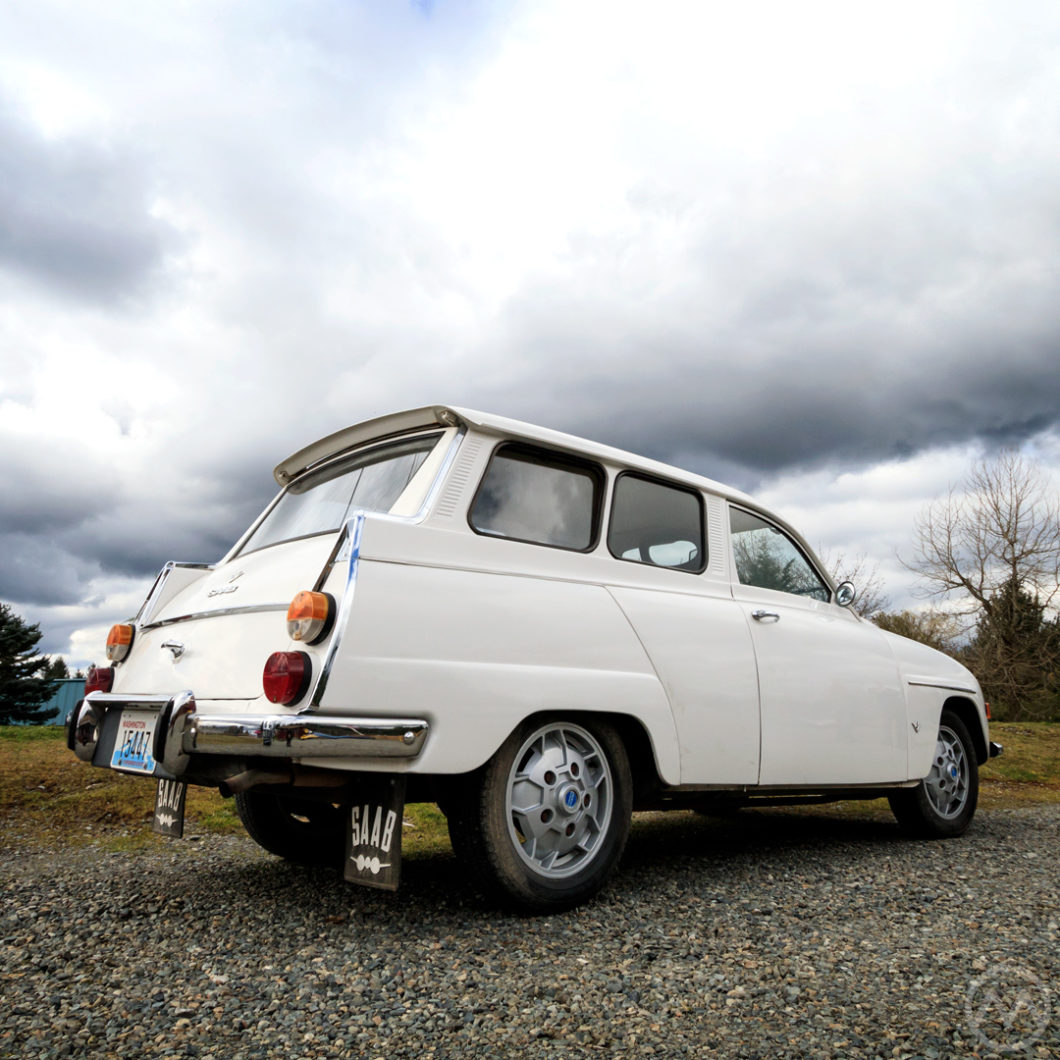The Saab 95 was the first car from Trollhätten to truly expand on the Saab formula. It arrived a decade after the first production Saab, the 92, but its roots in the “Ursaab” project of the late 1940s were clear. Saabs were evolutionary, and 95’s 19-year run would certainly prove that.
Though clearly evolutionary, the 95 added a capacious rear and extra length to the existing Saab platform in hopes of doing battle with small estates like the DKW Universal, a car that was probably its closest competitor.
Saabs, in the 1950s, were sometimes thought of as “Swedish DKWs,” as the Auto-Union brand was then far more familiar to the public than Saab, which only began exporting cars out of Sweden in 1955, and only in small numbers at first. The two were similar in many ways: front-drive, powered by two-stroke triples, and unconventional in appearance.
The comparison was apt, since DKWs and Adlers were some of the cars Saab’s original development team, which included Gunnar Ljungström and designer Sixten Sason, had targeted when they were designing the original Ursaab prototype.
By 1959 the company and the cars had grown, and the mainstay – the evolutionary 93, was about to give way to the 96 and the 95 estate. Developments of Saab’s two-strokes were still at the heart of these cars, and they were simple and well engineered machines.
The 95 debuted before the 96, and was a mixture of new and reused 93 pieces – but it added a great deal of functionality as a wagon or (more rarely seen) panel van.
Both the 95 and the 96 (which arrived a few months later in 1960) were successful until the mid-1960s, when changing customer expectations and emissions rules meant the two-stroke had to be put out to pasture.
2-strokes punch way above their weight in power – the early Saabs were quite fast for small, sub-1-liter cars. But 2-strokes smoke and require mixing oil into the gas – both consumer drawbacks for non-car people. They also have very high emissions. That wasn’t a factor in the 1950s when the 95/96 were being evolved from the 93, but in the mid-1960s, emissions laws threatened sales and the ability to certify cars, particularly in the USA.
This situation led to a dramatic change under the skin, and one that defined the 95/96 and the derivative Sonett for the rest of their production run. Instead of two strokes, Saab would fit Ford’s German V4 – a rare example of a four-cylinder Vee setup that had it’s own colorful history.
The Ford V4
V4’s are quite rare, since they’re not the smoothest powerplant (they have a great deal of inherent vibration) and often an inline four can be made just as physically small as the Vee setup. Only Ford, Lancia, and Ukraine’s ZAZ (Zaporozhets) ever offered the configuration in production cars.
Ford’s V4 came from Germany, but had a Dearborn connection.
The V4 came from Ford’s first front-drive production vehicle, the Taunus 12M (also called the Taunus P4 internally). This car put Ford of Germany at the front of a market change to front-wheel-drive – at the time only DKW/Auto-Union was offering front-drivers among the German competition, a position Ford of Germany – typically going with conservative designs – had not previously enjoyed.
Ford exec Robert McNamara learned of the development of this car and decided that it would make a good Volkswagen fighter in the USA, and an elaborate plan for creating a U.S.-version of the 12M got as far as the production engineering stage.

When McNamara departed to work as President Kennedy’s Secretary of Defense, Lee Iacocca was tasked with dealing with “Cardinal,” and chose not to produce what he saw as a car that was just a better fit for Europe than for North America. Nevertheless, the car got built in Germany.
The compact, light car had a very conventional appearance and sold well, ending up restyled (with a remarkably Detroit-like look) in 1967 into the 15M (P6). Opel’s cheaper-to-build rear-drive cars, however, did better.
The V4 was compact and light and designed for the purpose of fitting neatly into the 12M without adding too much weight. The engine was a little rough but quite versatile, and ended up serving in many Ford cars and trucks ranging from the original Taunus to the Transit and Capri. In 1965, the basic powerplant was extended into V6 form, becoming the long-lived “Cologne V6,” which was still with us into 2011.
Saab Needs an Engine
As previously mentioned, Two-stroke engines gradually fell away in the 1960s as customers were less interested in mixing oil and fuel at every fill up, and because of complaints about their smokey wake. Nevertheless, Saab production continued to increase steadily throughout the 1960s until 1966.
That year, Saab modified the two-stroke to use less oil and use triple carburetors in hopes of getting more power and a cleaner burn. The revised engine did do that, but it also used more gas – a situation that Europeans revolted against, since the car was an aging design (despite a mild 1965 restyle) that now cost more to operate.
Sales sank by almost 20% in 1966 and the company soon realized it had to do something to replace the two-stroke. However, there wasn’t time or budget to design and tool up for a whole new engine. Saab, at this point, was only producing 37,000 cars a year.
Technical director Rolf Mellde had seen the writing on the wall some time earlier and began a covert search for an off-the-shelf powerplant. These experiments went back as far as 1962, and were often carried out by Saab’s test team, Kjell Knutson and Ingvar Andersson.
Numerous choices were tried – the Llloyd Arabella’s tiny 897-cc four, the BMC’s 850 A-series (actually a whole Mini drivetrain mounted backwards), and the Lancia Appia’s 1,089-cc V4 (which must have been a sweet prototype).
Nevertheless, Mellde’s views were not shared by management in the early 1960s. Saab boss Tryggve Holm had him stop work on these ideas until Mellde took the radical step of talking to the Wallenberg family, powerful Saab shareholders, on his own.
Saab’s engineers started working on a proper evaluation program for a “purchased” four stroke engine in February of 1965. Per Gillbrand and Olle Granlund were among the engineers tasked with evaluating engines from Ford, Hillman, Lancia, Opel, Triumph, Volkswagen, and Volvo.
The existing architecture of the 95/96 meant any new engine would be a tight fit – and though the Volvo B18 was the preferred favorite in terms of operation, Ford’s V4 was a close second and a much easier fit.
According to Granlund, after several hundred hours of testing and production design modified to house the engine worked out, Mellde then met with Ford’s Don Frey in Detroit to clear the plan with Ford’s U.S. management. The contract for engine supplies was then worked out with Cologne.
In early 1966, Gillbrand took off for Italy to do long term testing of a V4 96. Once this secondary testing was complete, Mellde ordered a go-ahead for production, and the V4 Saab was born in the fall of that year.
A fleet of more than 600 already-built two-stroke cars were converted V4s for the launch, which was a major event in Sweden.

The V4 picked up where the two-stroke left off – with sales soon rebounding by 20%. After a period of offering the old and new powerplants concurrently while stocks remained, the two-stroke was dropped. In the USA, now a popular export market, the two-stroke cars continued for model year 1967, with the V4 cars arriving that fall.
The more conventional engine greatly increased the car’s appeal for buyers who’d have shied away from the two-stroke, but it was one of the very few things about the 96, and it’s 95 wagon counterpart, that was “conventional.”
The Last Saab 95
In 1969 the more conventional and ultra-modern 99 debuted, relegating the 95/96 to the bottom of Saab’s lineup, but the pair remained popular anyway.
One thing that the new 99 did not offer, at least in those early days, was a wagon. The 96 may have been eclipsed by the new 99 in some ways, but the Saab 95 still offered it’s huge interior and extra size.
In the early 1970s Björn Envall created a Citroën GS-like variation of the 95, the “Saab 98” prototype that modernized the idea, but it did not get built. Instead, the 95 was supplanted by the 99’s “Combi Coupe” body – not a proper “wagon” but just as big inside.
The 95 was also unique in Saab’s pantheon of products for a long time – after it was dropped in 1980, the company didn’t make another production wagon until the 9-5 in 1998.
From the time the V4 was added until the end of production the cars didn’t change much. U.S. models, which were withdrawn form North America after 1974, got various safety and emissions updates, while European models got bigger bumpers and more safety equipment.
Supplanted by the Combi-Coupe and always a little more of a niche model than the budget-minded (by 1975) 96, the last Saab 95 was built in 1978. 110,527 of the little wagons were made.

